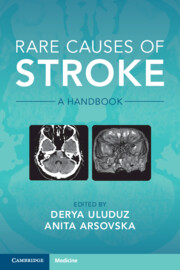Book contents
- Rare Causes of Stroke
- Rare Causes of Stroke
- Copyright page
- Contents
- Contributors
- Preface
- 1 Inflammatory Conditions
- 2 Infectious and Postinfectious Vasculitis
- 3 Hypercoagulable Causes of Stroke
- 4 Drug-Related Stroke
- 5 Hereditary and Genetic Causes of Stroke
- Chapter 5.1 Genetic Collagen Disorders
- Chapter 5.2 Genetic Small-Vessel Diseases
- Chapter 5.3 Genetic Metabolic Diseases
- 6 Rare Causes of Cardioembolism
- 7 Vasospastic Conditions and Other Vasculopathies
- 8 Other Non-inflammatory Vasculopathies
- 9 Venous Occlusive Conditions
- 10 Bone Disorders and Stroke
- Index
- References
Chapter 5.3 - Genetic Metabolic Diseases
from 5 - Hereditary and Genetic Causes of Stroke
Published online by Cambridge University Press: 06 October 2022
- Rare Causes of Stroke
- Rare Causes of Stroke
- Copyright page
- Contents
- Contributors
- Preface
- 1 Inflammatory Conditions
- 2 Infectious and Postinfectious Vasculitis
- 3 Hypercoagulable Causes of Stroke
- 4 Drug-Related Stroke
- 5 Hereditary and Genetic Causes of Stroke
- Chapter 5.1 Genetic Collagen Disorders
- Chapter 5.2 Genetic Small-Vessel Diseases
- Chapter 5.3 Genetic Metabolic Diseases
- 6 Rare Causes of Cardioembolism
- 7 Vasospastic Conditions and Other Vasculopathies
- 8 Other Non-inflammatory Vasculopathies
- 9 Venous Occlusive Conditions
- 10 Bone Disorders and Stroke
- Index
- References
Summary
Fabry disease is a rare multisystemic X-linked lysosomal storage disease characterized by lysosomal alpha-galactosidase A (α-Gal A) enzyme deficiency that results in globotriaosylceramide (Gb-3) accumulation inside the body. The incidence of the disease has been estimated to be approximately 1 in 40,000 to 1 in 117,000 in the general population. Male patients and symptomatic heterozygous females have symptoms including skin lesions, acroparesthesia, corneal and lenticular changes, abdominal pain, chronic diarrhea, proteinuria and hypohidrosis. Later, progressive vascular involvement leads to renal insufficiency, cardiovascular dysfunction and stroke. Treatment should include enzyme-replacement therapy (ERT) and adjunctive therapies under the supervision of a multidisciplinary clinical team. ERT is available in the forms of agalsidase alfa and agalsidase beta. We present a 21 year-old male with recurrent stroke and Fabry disease, treated with ERT
Keywords
- Type
- Chapter
- Information
- Rare Causes of StrokeA Handbook, pp. 246 - 252Publisher: Cambridge University PressPrint publication year: 2022



